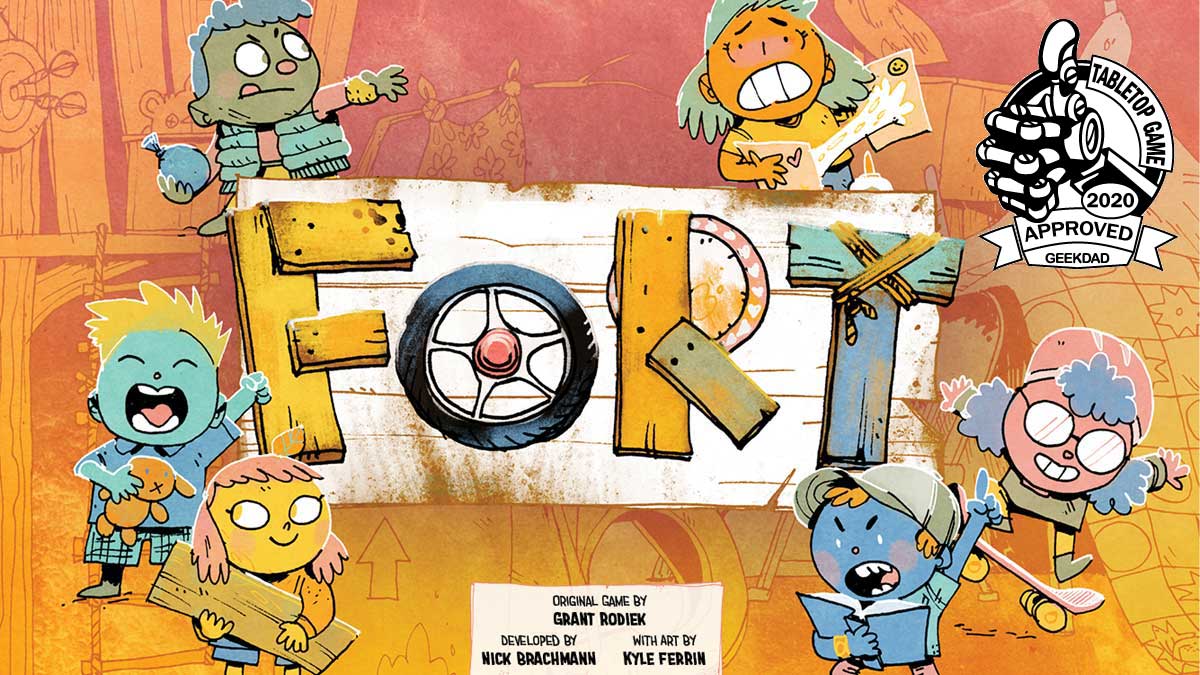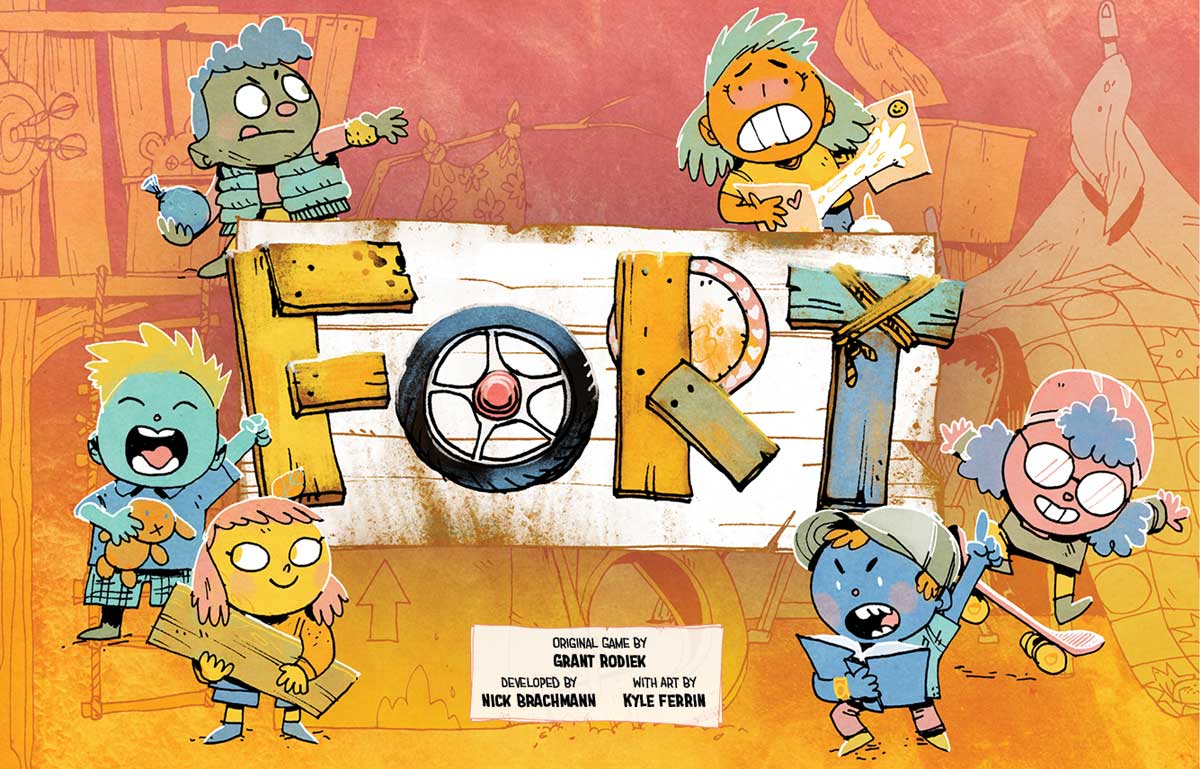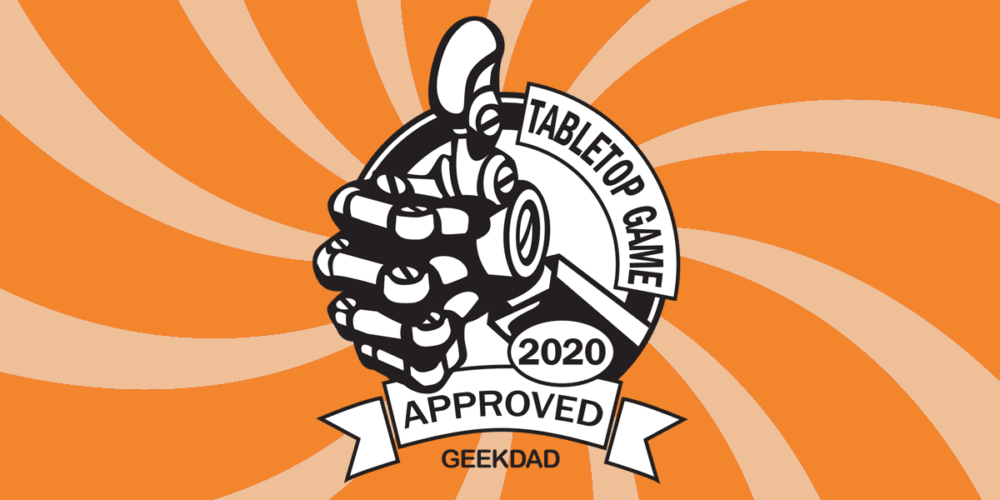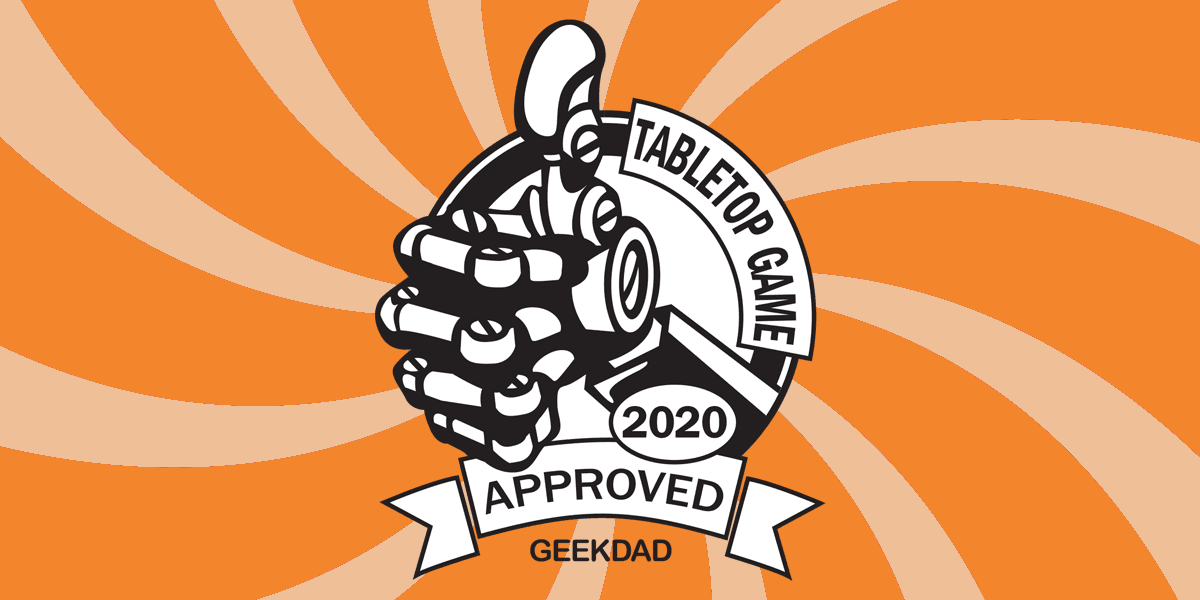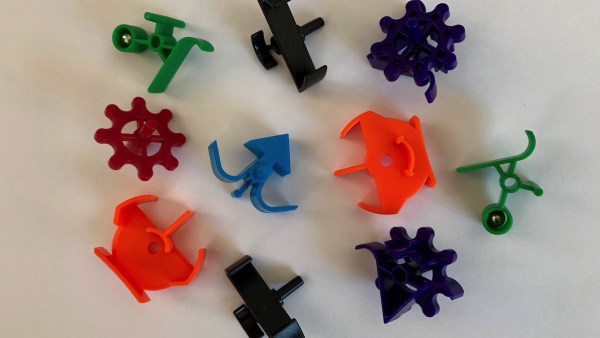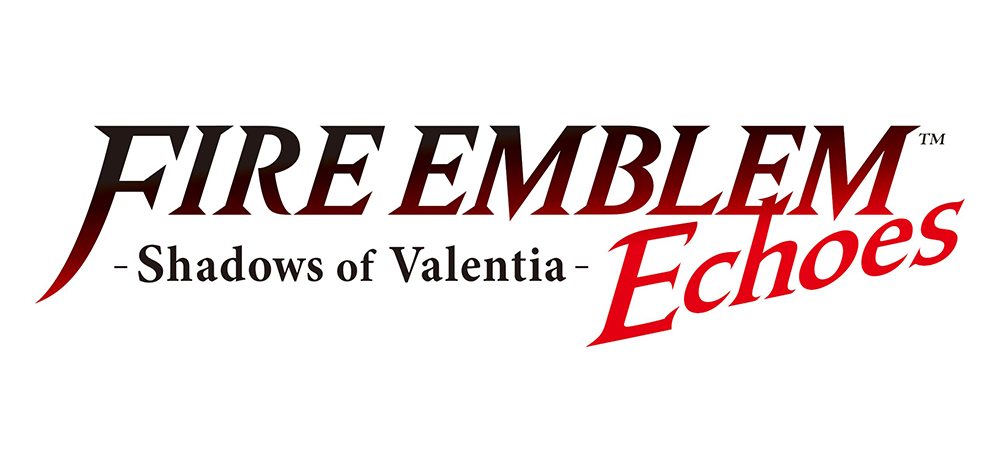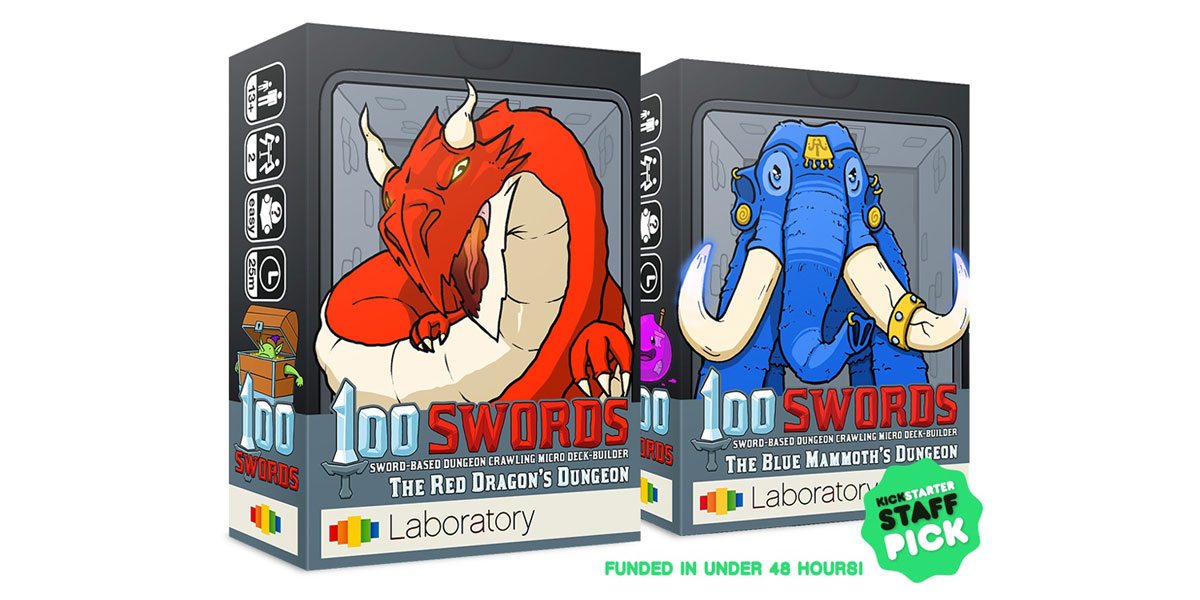Grab your friends and build the best Fort! But remember: kids you don’t play with just might wander to somebody else’s yard.
What Is Fort?
Fort is a deck-building game for 2 to 4 players, ages 10 and up, and takes about 20 to 40 minutes to play. It is currently available for pre-order from Leder Games for $30 (plus shipping), with an expected retail release date of August 25. (I’ll note that the gameplay will be a bit longer when you’re still learning the game, but 20–40 minutes seems reasonable for players who no longer need to consult the player aid for the various action icons. Currently my 2-player games still take about 30 minutes.)
Fort was designed by Grant Rodiek (and originally self-published in a different form as SPQF). It was developed by Nick Brachmann for Leder Games, with illustrations by Kyle Ferrin.
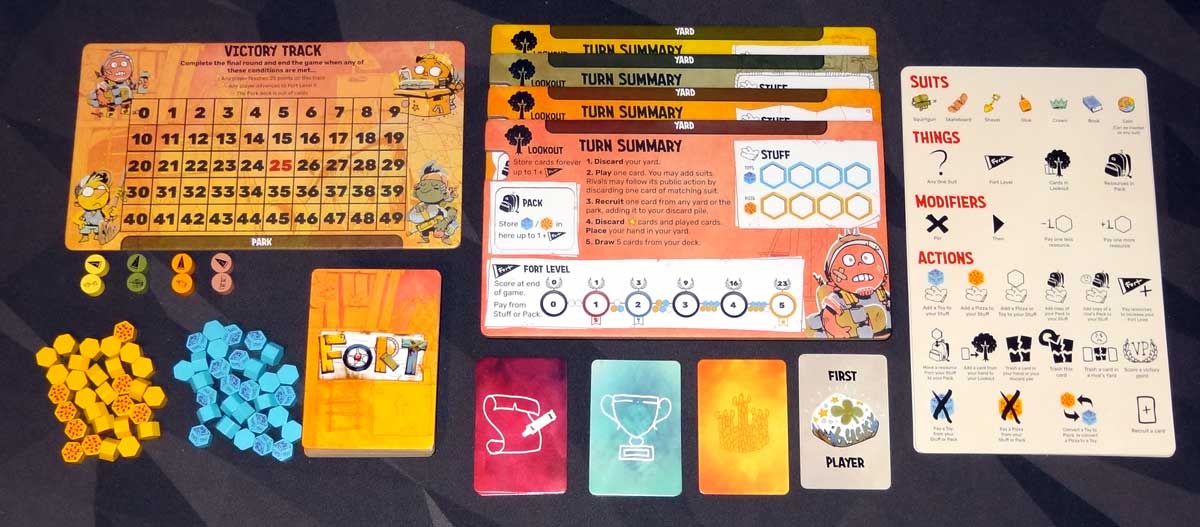
Fort Components
Here’s what comes in the box:
- Victory Track board
- 4 player boards
- 4 Score markers
- 4 Fort markers
- 30 Pizza tokens
- 30 Toy tokens
- 68 Kid cards
- 10 Made-Up Rule cards
- 10 Perk cards
- Macaroni Sculpture card
- First Player card
- 4 Reference sheets
The component quality is nice: the player boards are dual-layered, with wells to hold various tokens in place. There’s also a cut-out on the left side where you can tuck a card and have the card icon show through, though I didn’t find this as necessary; in the game you can tuck multiple cards, so the cut-out is only useful for the first card.
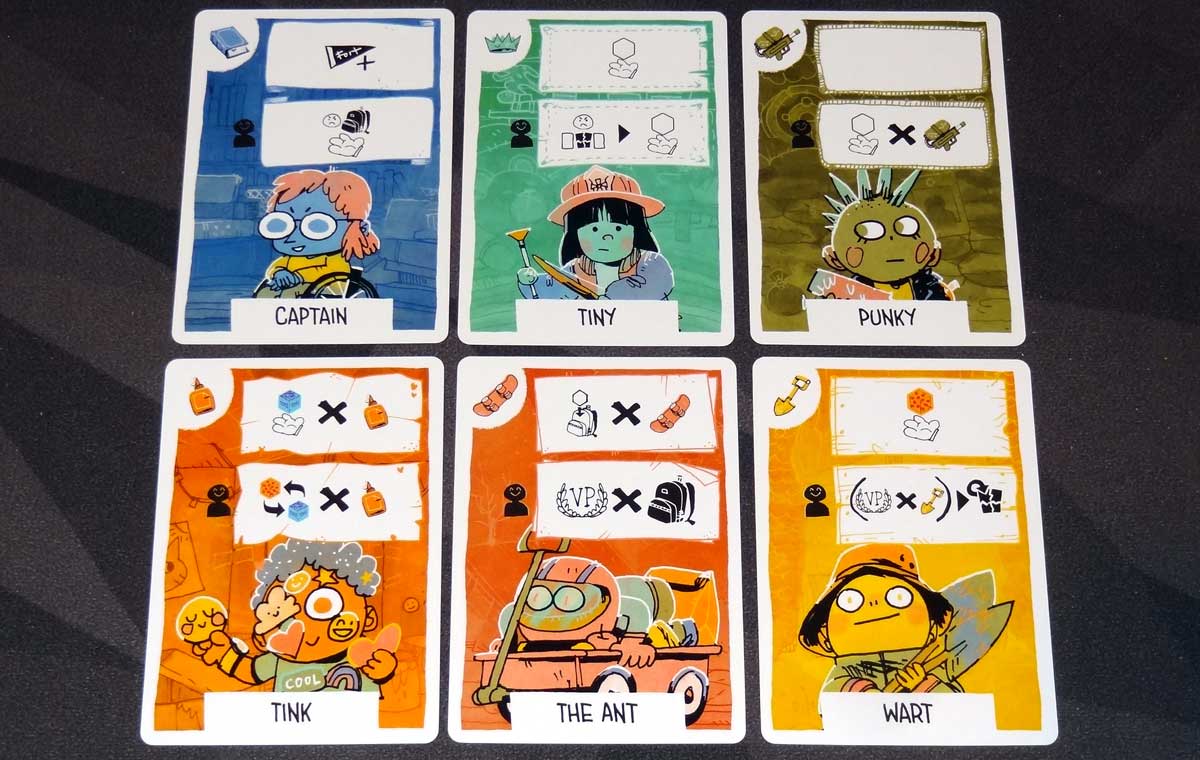
The kid cards are regular-sized, and all the others are mini cards. The cards are illustrated by Kyle Ferrin (who has also illustrated Leder Games’ other titles, like Vast and Root) and they’re a lot of fun. There are six main suits in Fort: book, crown, water gun, glue, skateboard, and shovel (plus a wild suit, coin). Most of the kids reflect the suit they belong to somehow: the skateboard suit tends to have a vehicle of some sort, the glue suit usually involves crafts, and so on.

A fun touch on the backs of the player boards are the descriptions of your “best friends,” which are the two cards you start with in your deck. They’re just little bios of the kids and add a little flavor to the game.
The wooden bits are screen-printed: the fort and scoring tokens are cylinders in the player colors, with a “fort” pennant and the suit icon, respectively. The resource tokens are toys and pizzas, and are hexagonal bits. It’s amusing to me that the pizzas are hexagonal, but it makes the tokens the same shape.

The box insert is all right, except that the well for the mini-cards is a little shallow. It worked fine when the cards were still in shrink wrap, but once I opened them, they overflow it a little and slide around. Fortunately, they’re underneath the larger cards, and there are extra wells for those, so overall things do tend to stay put.
How to Play Fort
You can download a copy of the rulebook here. You can also try it for free on Tabletop Simulator.
Fort is a deck-building game, which means that each player manages their own deck of cards and personal discard pile. When your deck runs out, you shuffle your own discard pile to make a new deck. Over the course of the game, you will gain new cards, but you may also lose cards as well.
The Goal
The goal of the game is to score the most points—by building up your fort, following your made-up rule, and using various kid abilities.

Setup
In the center of the play area, place the victory track board, the supply of pizza and toy tokens, and the deck of kid cards. Shuffle the perk cards and place one more than the number of players face-up, returning the rest to the box. Shuffle the made-up rule cards and make a stack of one more than the number of players, placed face-down. Place the macaroni sculpture card nearby.
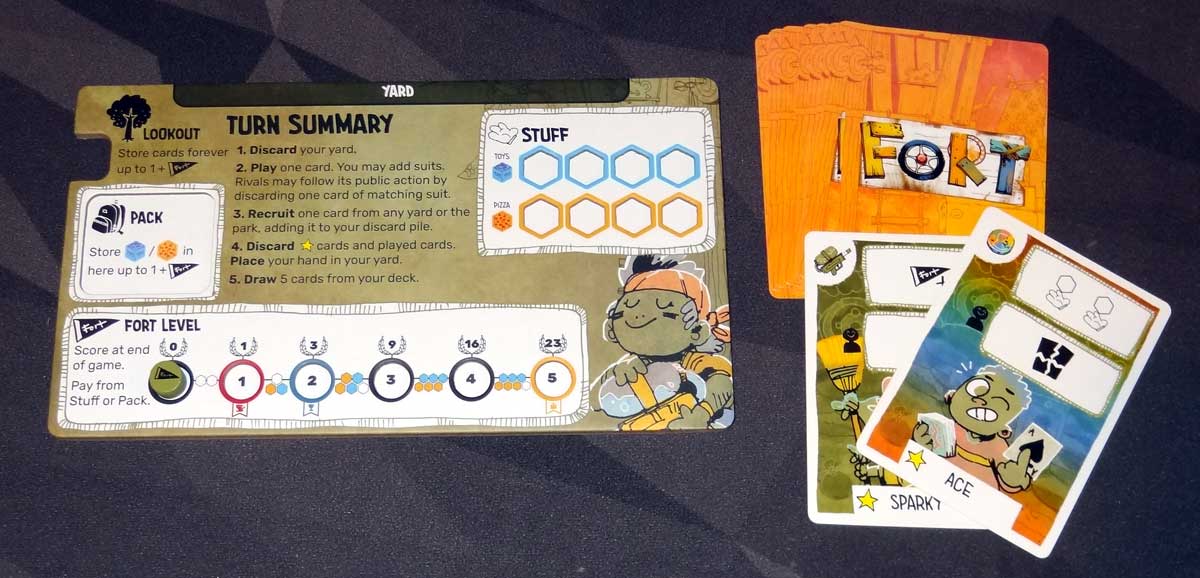
Each player gets a player board and the matching tokens: place your scoring token on “0” on the victory track, and your fort token on the “0” level of your fort. Your starting deck consists of your two Best Friend cards (marked with a star), listed on the back of your player board, plus 8 random cards from the kid deck. Shuffle these together and set them near your player board, and then draw 5 cards. (Alternatively, players can draft their starting kids by picking and passing the 8 kid cards.)
Choose a first player and give them the first player card.
Gameplay
Fort is a deck-building game, so each player has their own deck and discard pile. Unlike many deck-building games where you play out your whole hand of cards, in Fort you play a single card, and other players have an opportunity to follow your action.
At the beginning of your turn, if you have any kids in your yard (in front of your player board), you place them in your discard pile.
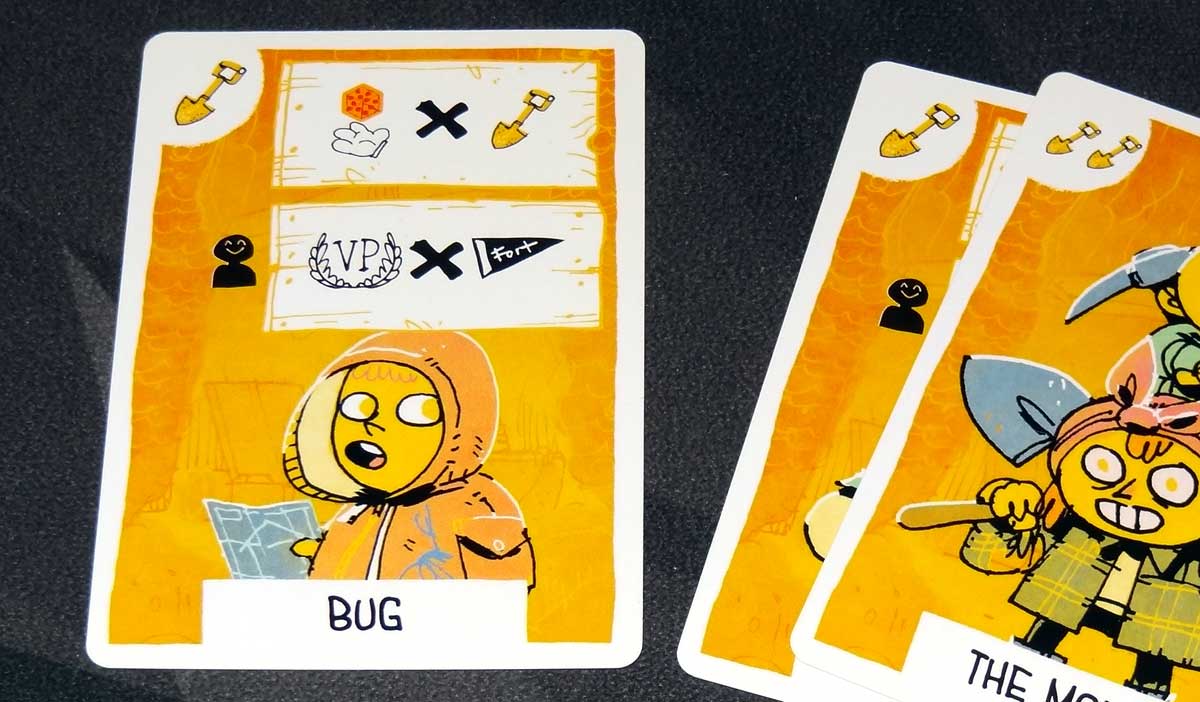
Choose a card from your hand and play it to the table so everyone can see it. Each card has two actions on it: the top action may be followed by other players, and the bottom action is only for you. You can do the actions in either order, but you must fully complete one action before doing the second. (And if you can’t completely do one action, then you can’t do the second one at all.)
Some actions, like the top action on Bug seen above, are multiplied by a particular suit. You may discard additional cards from your hand that match the suit to boost the actions. In this case, you would get to take 4 pizzas because of the 4 shovels (one on Bug and 3 from the other cards). If you have cards in your lookout that match the icons required, you may also count them to boost your own actions.
Other players may each discard a single card matching your card’s suit in order to follow the top action. Lookouts do not help when you’re following, and you may not discard multiple cards to boost when you’re following.
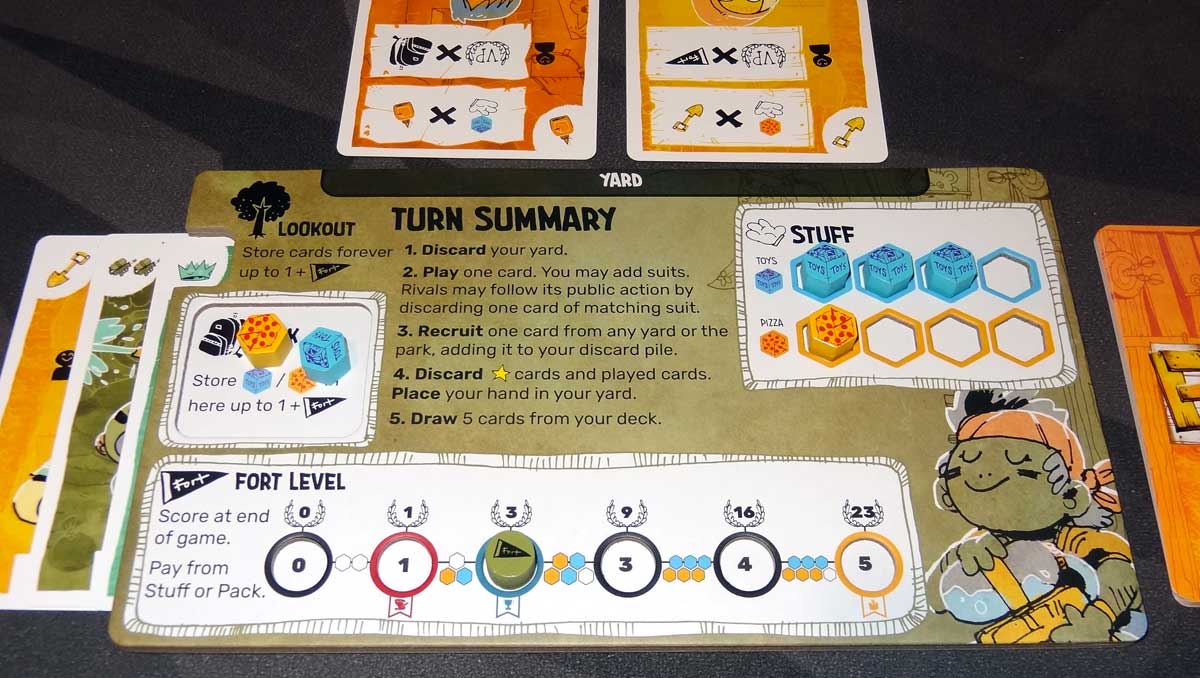
After resolving your action, you must recruit a new kid: take a card from the park (the 3 face-up cards below the score board), the kid deck, or another player’s yard, and place it in your discard pile. Then, discard your played card, any cards you used to boost your action, and any of your best friends (marked with a star). Any cards left in your hand go into your yard, facing away from you: if you don’t play with a kid, then they might decide to go visit somebody else!
Then, draw a new hand of 5 cards, and it’s the next player’s turn.

That’s basically how the game works, but of course there are a lot of details I’ve glossed over. There are several types of actions that deal with managing resources: getting pizza and toys, trashing cards, and scoring points for specific things like the number of cards in your lookout or the number of books you have. The pack area on your board is extra storage for resources–it’s limited by your fort level, and you can only move things into it using specific actions. There are some actions that let you make a copy of your pack and add it to your stuff, or even some that let you copy an opponent’s pack.

And what would a game called Fort be without a fort? Each player has a fort level at the bottom of their player board. You start at 0, but you can use a fort action to build it up, using a combination of pizza and toys. Increasing your fort level will give you points at the end of the game, plus it increases the capacity of your pack and lookout. There are also some bonuses for reaching certain levels.
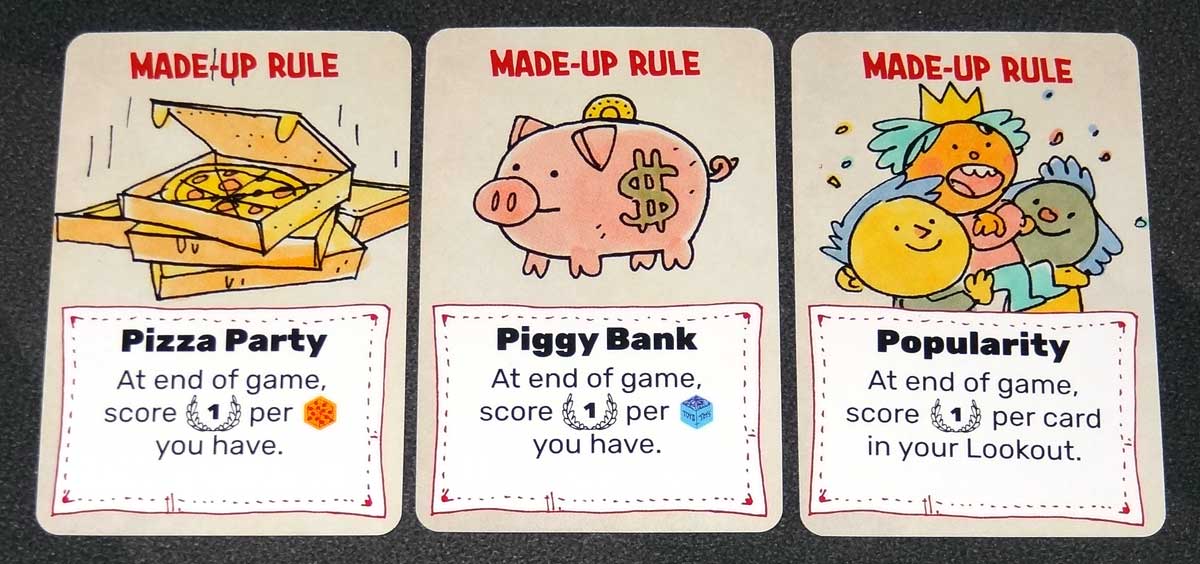
When you reach level 1, you get to choose a made-up rule from the deck, placing the rest back face-down. Each made-up rule will give you points at the end of the game for a specific condition, like having the most kids, or getting one of each suit, and so on. These are kept hidden until the end of the game.
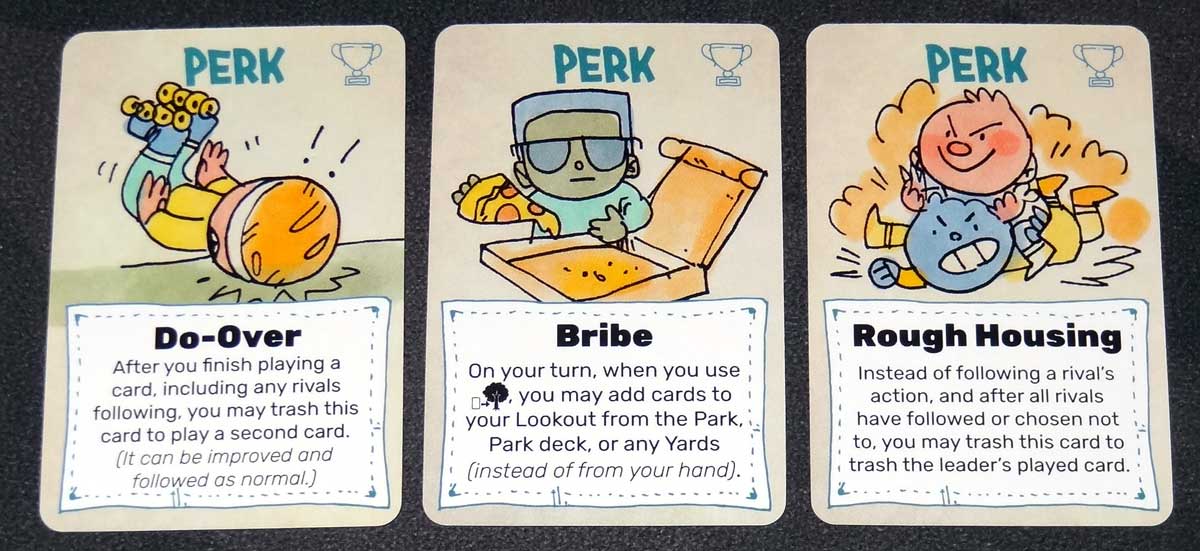
When you reach level 2, you get to take one of the face-up perk cards. Perks give you special abilities; some are one-time-use and are trashed after you use them, and some offer ongoing abilities.
Game End
There are 3 ways to trigger the game end, helpfully noted on the score board:
- When a player reaches fort level 5
- When a player reaches 25 points
- When the kid deck runs out
(If you’re the first to reach level 5, you also take the macaroni sculpture, which is worth 4 extra points.)
When the game end has been triggered, finish the round so that all players have had the same number of total turns. Then, add in points for everyone’s fort level, made-up rules, and the macaroni sculpture. The highest score wins!
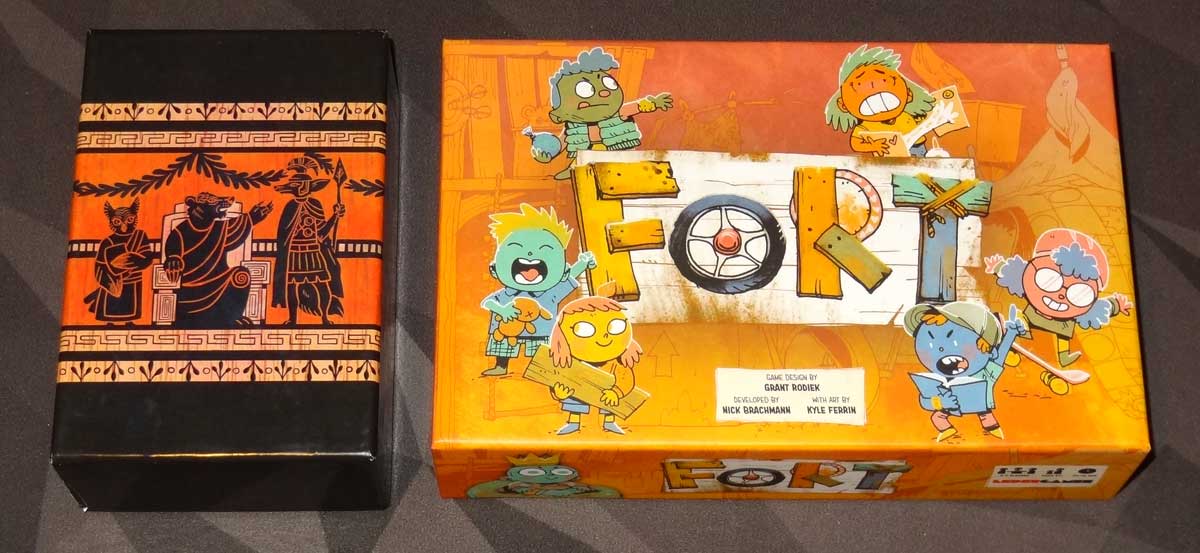
What’s the Difference Between SPQF and Fort?
I mentioned above that this had originally been published by Grant Rodiek as SPQF. I backed SPQF when it was originally on Kickstarter, and I was curious to see what had changed between the two versions besides the artwork and theme. Here’s a quick look to show you some of the differences.
The box for SPQF is substantially smaller, and since it was designed for Kickstarter only, it has very little text or other information on it other than some creator names on the back of the box.
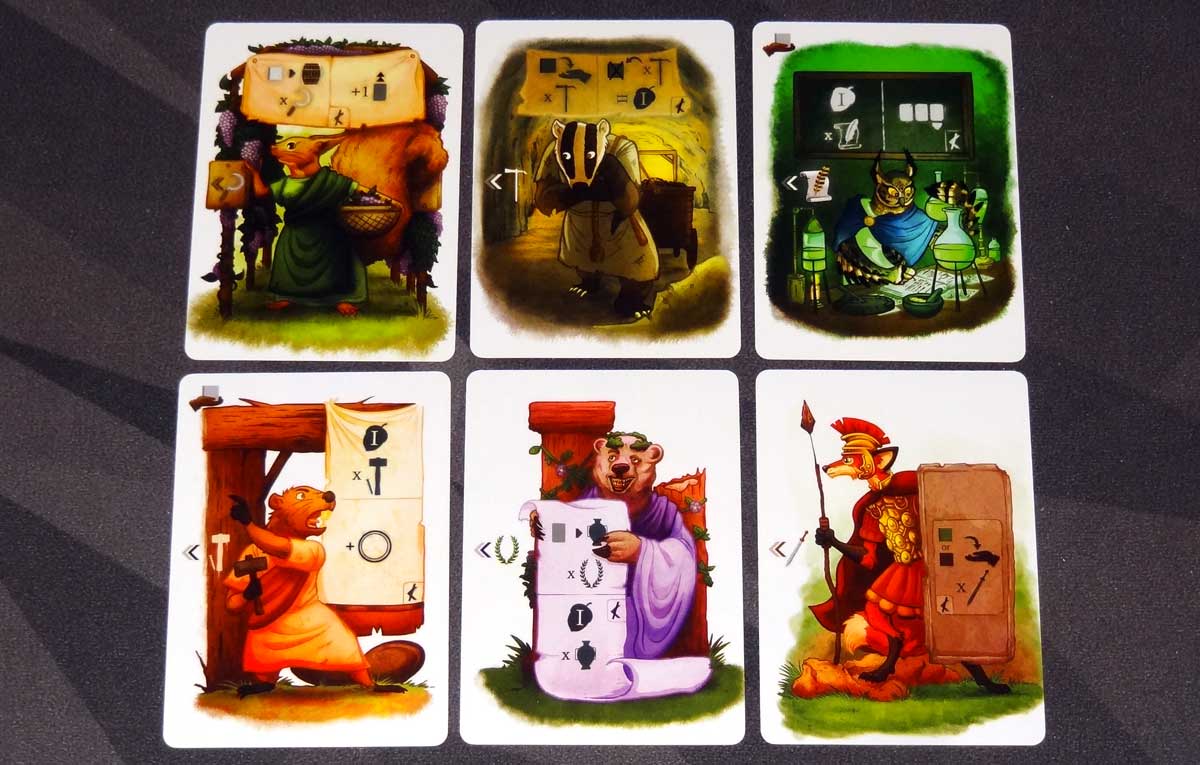
The core of the gameplay was the same, but the theme was about Roman animals in a forest (with the title being a reference to SPQR: the Senate and People of Rome). In the original game, each suit had one piece of art (by Sid Quade), with different icons for different actions. In Fort, each specific set of actions has a unique kid illustration and name (though there are 2 copies of most kids). You’ll also notice that in SPQF, the action areas are incorporated into the artwork–kind of a cool effect, but it meant that the actions weren’t always in the same place on each card, which could make it a little harder to read. Cards that cost resources to play had a little hand icon in the top left corner, rather than having that icon in the action box.
SPQF had a distinction between actions that could be followed and those that couldn’t, with a funny little icon to indicate that, because some cards only had a single action on them. In Fort, every card uses the same format, but some cards simply have an action only on the top (can be followed) or bottom (cannot be followed), which seems easier to parse.
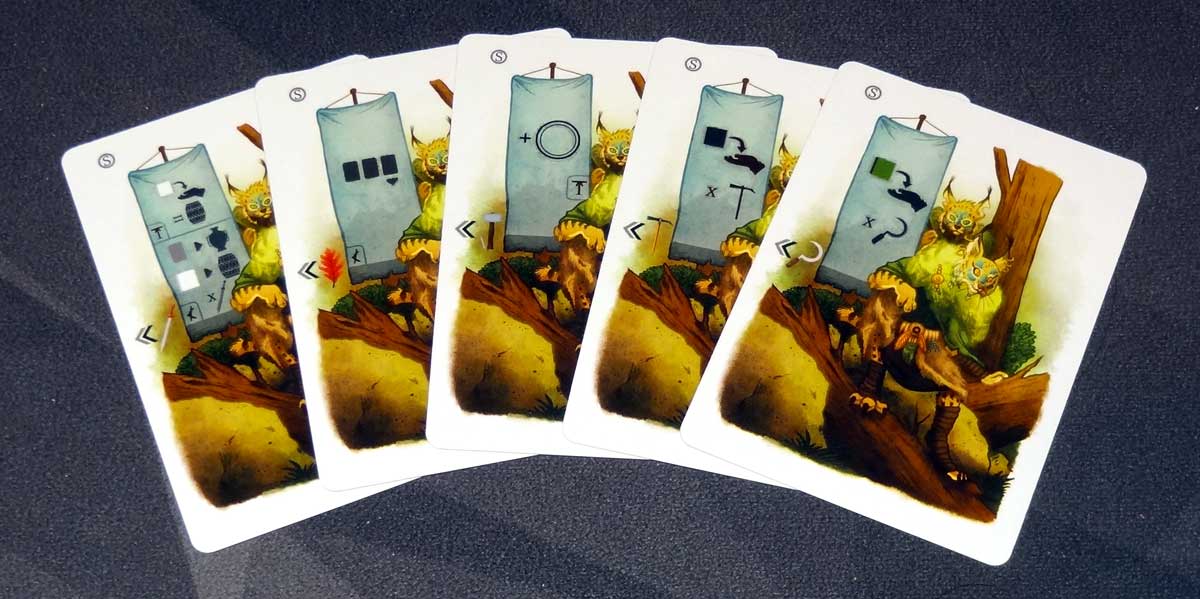
In SQPF, everyone has the same 5 starting cards, covering 4 of the primary suits and the wild leaf suit. You add 5 random cards from the deck to this for your starting deck. In Fort, you only start with two best friend cards, one in your player color’s suit, and one with a coin, but they’re all the same actions. What this means is that in SPQF your starting cards can follow the other player’s starting cards, but in Fort everyone will start with a fort-building card of a different suit.
Many of the actions on the cards are similar between the games, though SQPF included one in particular that is notably missing in Fort: the ability to trigger the action on a card in a trade row (now called the park and the yards). It’s a powerful action that would let you use a card without having to recruit it first.

The components in SPQF include some laser-cut wood pieces. As you can see in the photo above, the player board is much smaller than in Fort, and the game used acorn scoring tokens rather than a scoreboard. Instead of a pack area on the board, there are storage spaces below the civilization track (equivalent to the fort level), each holding one cube. I do like this a little better than Fort‘s system, where I’m constantly counting to make sure I haven’t exceeded my pack capacity, but I’m not a huge fan of laser-cut wood as a finished game component otherwise.
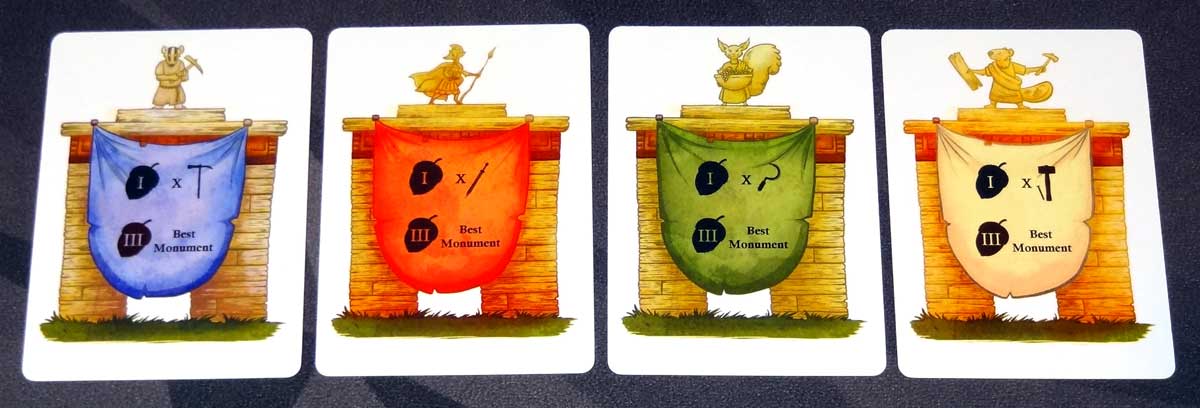
Instead of made-up rules, SPQF had monument cards, which were dealt to players at the beginning of the game. Each one awards you bonus points at the end of the game for a specific suit, plus bonus points if you had the best monument. Made-up rules in Fort are a little more varied, and are not randomly assigned–you get one when you reach level 1, so the earlier you upgrade your fort, the more options you have to choose from.
SPQF does not have anything equivalent to the perk cards in Fort.
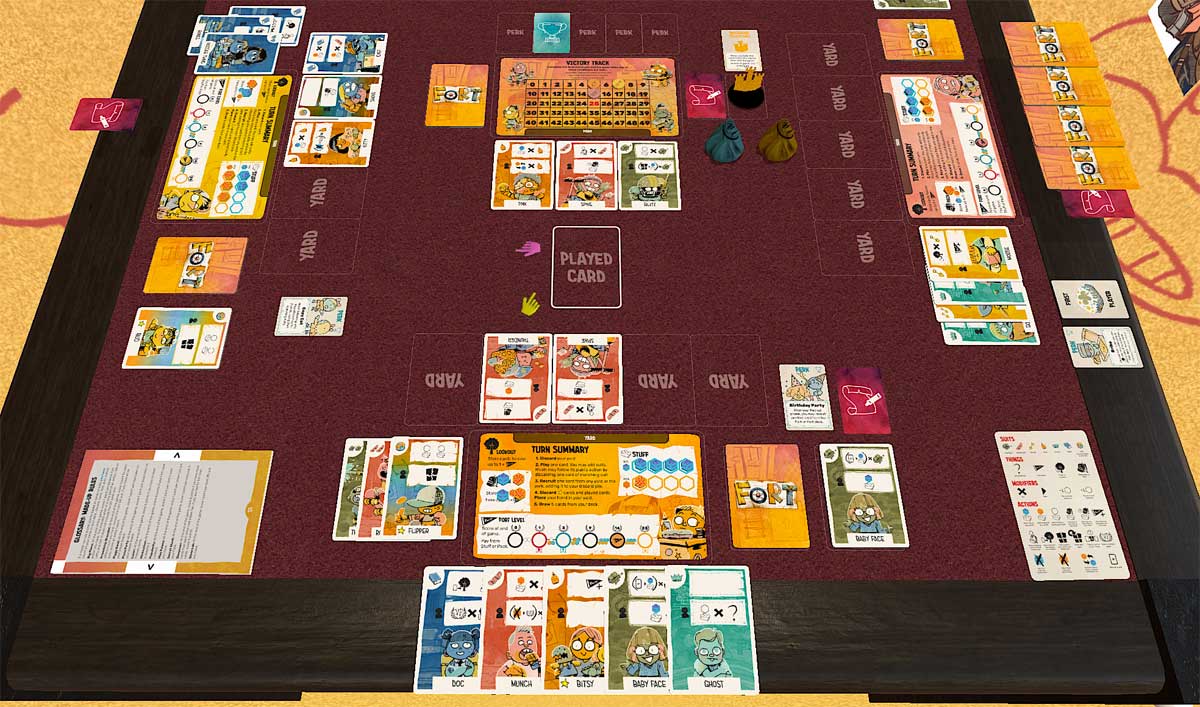
Why You Should Play Fort
Fort (like its predecessor SPQF) is a deck-builder that does some pretty fascinating things with the genre. Grand Rodiek, the designer, had expressed that there were already a lot of deck-building games out there, and he was looking to make something that stood out.
One of the biggest changes—and one that not everyone will enjoy—is the way that your cards might get taken by other players (and vice versa). A common complaint about early deck-building games is that they can feel like “multiplayer solitaire”: every person is building their own system, but you might not every directly affect somebody else’s deck. In Fort, you must add a card to your system every turn, but that card might come from the common market area, or it might come from another player’s yard. I like the way it ties into the theme in Fort, too: kids that don’t get played with are happy to find somebody else who will play with them.
Between that, and the fact that you only play one action card on your turn, Fort can present you with some conundrums. If you have several different suits in your hand, you most likely can’t use all of your cards to boost one action, so some of your cards will wind up in your yard, ready to be swiped by your rivals. Spending cards to follow another player’s action may not be as efficient as playing the card for your own action, but sometimes you do it simply to get the card into your discard so you won’t lose it.
For those who relish more player interaction, this “stealing” mechanism is a fresh idea that introduces some new challenges as you play. If you like the idea of building up your own engine without any outside interference, though, you may get frustrated that you can’t just build a fence and keep all the kids in your yard.
It can also be tough to decide how best to build your deck. If you focus on one or two suits, you might guarantee that when you play an action, you always have additional cards to boost it. However, then you miss out on following your rivals if they use different suits for their turns. On the other hand, if you collect a few of each suit, it may give you better odds on being able to follow your opponents, but it’ll be harder to get those card combos so your own turns are more effective.
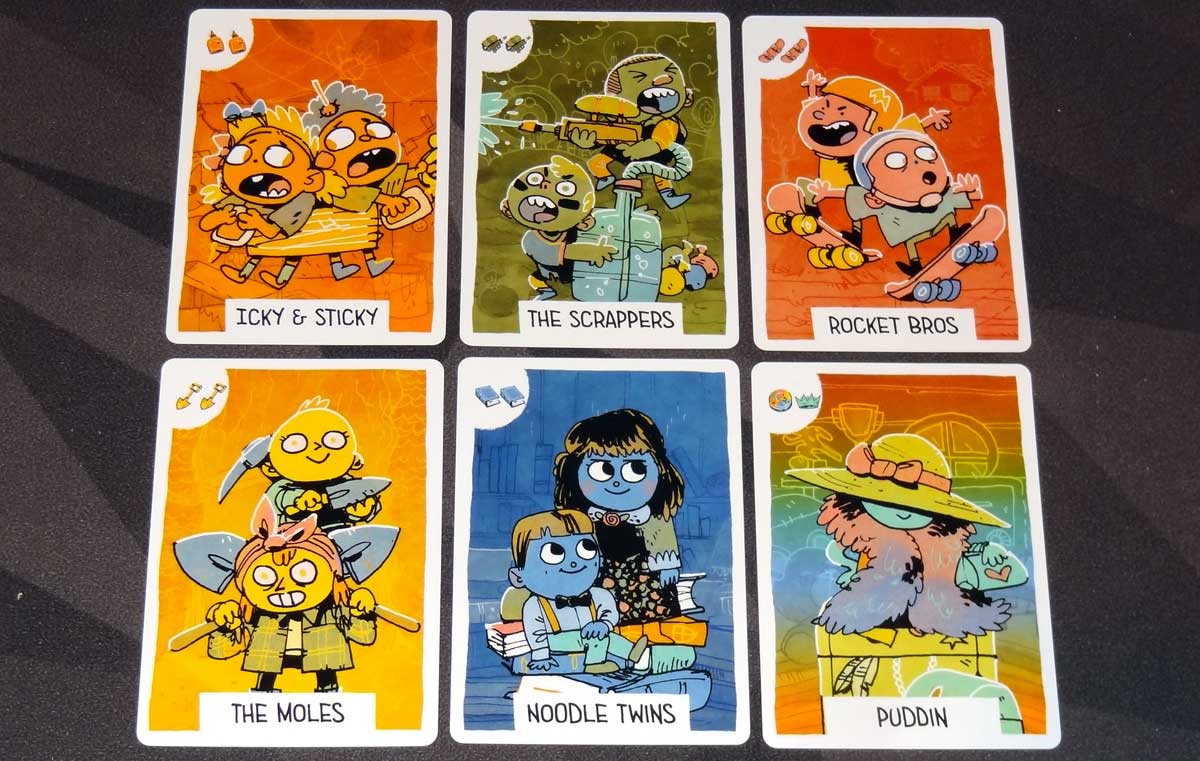
Following other players’ actions isn’t a new concept, but it is one that is not often seen in deck-building games. There are a few cards that have double icons on them, but no actions whatsoever. You can’t use them for an action, but they’re great for following or for boosting your own actions. If you can get them into your lookout, they can be especially powerful. Since they don’t have their own actions, it also means they can be hard to hang onto, and you can expect to see them bounce around between players a bit.
The following mechanism also means that everyone is engaged on every turn: you want to see what the other players are doing, and whether you can follow. You’re also paying attention because you want to see if they recruit one of your kids. In other deck-building games, it can be possible to check out while everyone else is taking their turns, but Fort moves quickly at one action card per player and keeps you involved.
Your starting deck is primarily made up of cards from the regular deck (whether you just deal them out or do the draft variant), with only two cards that would traditionally be called “starting cards.” In many deck-building games, you start with a deck of weaker cards and you start adding better cards, and hope that you can weed out some of the starting cards. Here, that’s not necessarily the case. Your two starting cards are actually pretty useful: one lets you build your fort, and the other is a wild suit and lets you take two resources, which is pretty flexible. There are actions that let you trash cards from your hand or discard pile, but in Fort it’s not always obvious which cards you want to trash.
Fort is GeekDad Approved!
I received a pre-release copy of Fort to try out, and I’ve played that several times with my daughter, as well as the Tabletop Simulator module with my remote friends. The iconography is not immediately obvious, but it makes sense, and I found I didn’t need the reference sheet after my first couple of plays. Likewise, the gameplay structure isn’t exactly like most deck-building games, but most players I’ve taught picked up on it pretty quickly, though remembering to discard the kids in your yard at the beginning of your turn may be the thing that most people forget.
I like the made-up rules and the perks, both as incentives for getting your fort built up quickly, but also for the way that they can help steer your strategy. Making them rewards for levels 1 and 2 of your fort means that they’re obvious early goals to aim for, which directs players to build up their forts, even if they didn’t immediately understand the value of expanding packs and lookouts. Plus, getting your made-up rule early helps you know at least one thing to aim for as you’re playing, and if you can find a perk that works well with your rule, even better.
While I did enjoy SPQF (and will be keeping my copy in my collection), I found it harder to teach: it just wasn’t quite as intuitive, whether because of the iconography or layout, or because of the theme, I’m not sure. Fort, with its lively illustrations of kids and weirdly hexagonal pizzas, feels more welcoming, even though much of the gameplay remains the same. I think Leder Games has done an excellent job, as they did with Root, of making a title more accessible and appealing even to an audience that might not have typically played this type of game.
If you love deck-building games (like I do) and want to try something a little different, Fort is worth checking out. If you haven’t played deck-building games before, Fort works fine even without prior experience, though keep in mind that other games in the genre will not play out the same way. It may not be a great fit for those who don’t like the idea of having their cards taken away from them, but otherwise I think it’s a unique take on the genre.
To place a pre-order, visit the Leder Games website!
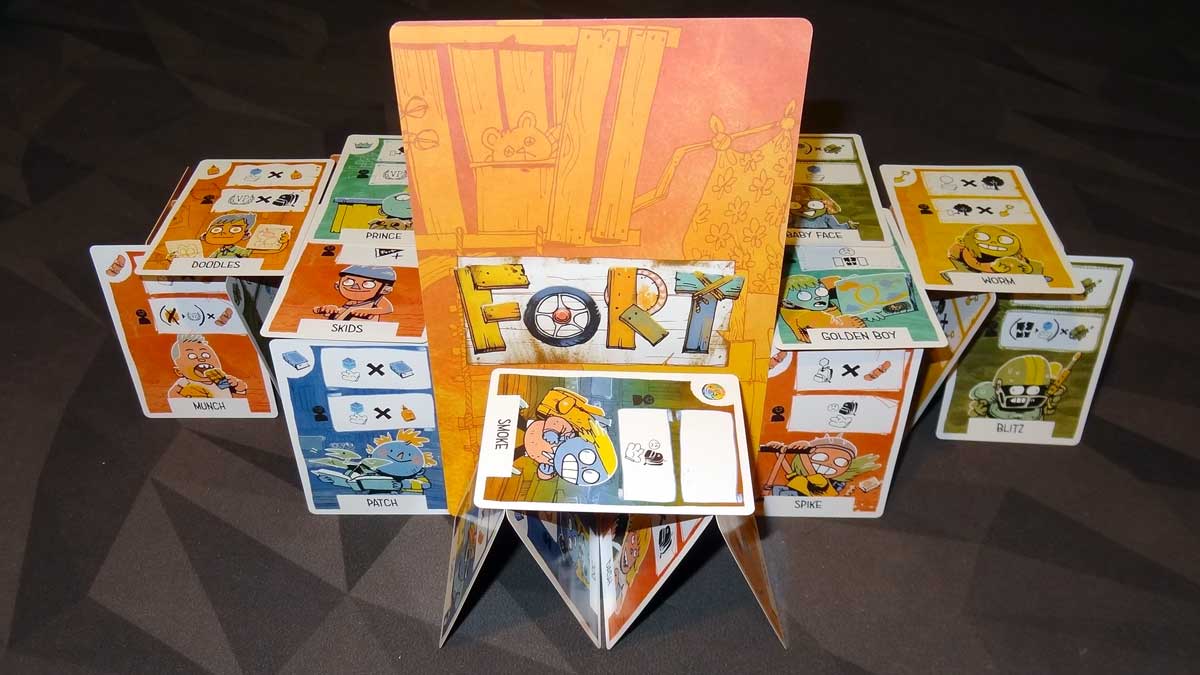
Click here to see all our tabletop game reviews.
![]() To subscribe to GeekDad’s tabletop gaming coverage, please copy this link and add it to your RSS reader.
To subscribe to GeekDad’s tabletop gaming coverage, please copy this link and add it to your RSS reader.
Disclosure: GeekDad received a copy of this game for review purposes.
